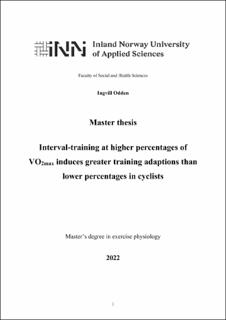| dc.description.abstract | Purpose: Training at high intensities is well known to improve endurance performance, yet the importance of training intensity measured as percentage of maximal oxygen consumption (VO2max) has never been verified. Thus, the present study aimed to investigate the importance of training intensity measured as the average percentage of VO2max elicited during every interval-sessions (%VO2max@IS) during an entire training intervention on changes in endurance performance and physiological determinants of endurance performance in cyclists.
Methods: Twenty-two cyclists (VO2max = 67.1 ± 6.4 mL·min-1·kg-1; males, n = 19; females,
n = 3) performed a nine-weeks training intervention including twenty-one 5x8-minutes interval-sessions at a mean power output (PO) corresponding to the individual cyclists´ 40-minutes PO. Oxygen consumption was measured during all interval-sessions, and the half of the cyclists eliciting the highest %VO2max@IS were allocated to HIGH (%VO2max@IS = 86.2 ± 3.8%; n = 11) whereas the half eliciting the lowest %VO2max@IS were allocated to LOW (%VO2max@IS = 79.9 ± 4.0%; n = 11). Physiological tests were performed prior to (pre), two times during, and after the intervention (post).
Results: Across both groups, the pre to post percentage increase in PO at 4 mmol·L-1 blood lactate concentration (PO@4mmol; p = 0.001) and in a performance index (composed of PO@4mmol, maximal aerobic PO (Wmax), and 15-minutes PO (PO@15min); p = 0.042) were both positively related to %VO2max@IS. Comparing HIGH to LOW, larger percentage increases were observed in VO2max (8.0 ± 4.3% and 2.7 ± 2.7%, p = 0.003), Wmax (8.6 ± 5.6% and 4.2 ± 2.8%, p = 0.035), PO@4mmol (7.8 ± 3.6% and 3.0 ± 4.5%, p = 0.013), and the performance index (7.7 ± 3.4% and 3.6 ± 2.9%, p = 0.007).
Conclusion: Performing twenty-one interval-sessions over nine weeks at a higher %VO2max@IS induces greater training adaptions than at a lower %VO2max@IS in cyclists. | |
